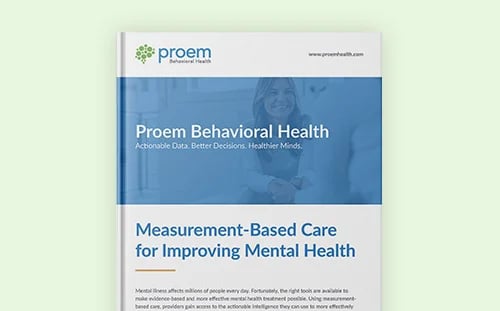Mental illness affects millions of people every year, making it challenging for them to enjoy everyday life and maintain recovery. The good news is that most common mental health disorders are treatable.

In this blog post, we take a broad look at mental health, defining the concept, sharing facts you should know, discussing causes of the disorders, and identifying five of the most common mental disorders.
What Is Mental Health?
Mental health is a state of wellbeing that involves emotional, psychological, and social actualization as an individual. It affects how people think, act, and feel while also helping them cope with life's everyday stresses. Mental health is vital for all stages of life. Sometimes the term is used to denote the absence of mental illnesses.
As the Centers for Disease Control and Prevention notes, poor mental health and mental illness are not the same. Although the terms are often used interchangeably, a person can experience poor mental health and not be diagnosed with a mental illness. Likewise, a person diagnosed with a mental illness can experience periods of physical, mental, and social wellbeing.
Mental Health Facts to Know
Every year, the National Council for Mental Wellbeing recognizes Mental Health Month in May. As part of this initiative, the council shares resources including mental health facts and figures. According to its mental health facts of 2021, approximately 50% of all lifetime mental illness begins by 14, and about 75% by age 24. Mental health facts shared by the World Health Organization reveal that at least one in five children and adolescents in the world will experience mental illness each year.
When we look closely at mental health facts for youth, the statistics are even more alarming. About 14% of adolescents in the United States have a mood disorder, including bipolar disorder and depression. Adolescents with mental conditions are mainly vulnerable to educational difficulties, social exclusion, and risk-taking behavior. The consequences of failing to address adolescent mental illnesses extend to adulthood, potentially impairing physical and psychological health and limiting opportunities to lead fulfilling lives. Furthermore, untreated or inadequately treated mental illness can lead to high rates of school dropout and other significant life challenges.
What Are 3 Facts About Mental Health?
While we've already provided some facts about mental health, let's look at three more revealing figures:
- More than 8 million people in the United States provide care for an adult with an emotional or mental illness.
- More than 30% of people experiencing chronic homelessness also have a severe mental illness.
- Approximately 70% of the youth in the juvenile justice system have at least one mental health condition.
Causes of Mental Health Disorders
The exact causes of individual mental health disorders are unknown, but years of research reveal a combination of biological as well as psychological and environmental factors as significant contributors. What do these factors mean?
- Biological factors — Some disorders are linked to abnormal functioning of nerve cell circuits or pathways that connect specific brain regions. Injury or defects in particular brain areas also cause a few disorders. Other biological factors leading to mental illness include genetics, infections, prenatal damage, and substance abuse.
- Psychological and environmental factors — These contributors relate to how an individual connects with others. Attitudes and behavior often aggravate mental disorders or symptoms, with some instances resulting in hospitalization or a visit to an emergency room. Psychological and environmental factors that may contribute to mental illness include neglect, loss of a loved one, dysfunctional family life, inability to relate to peers, and social or cultural expectations.
What Are the 5 Most Common Mental Disorders?
Now let's take a closer look at different examples of mental health disorders. Here are five of the most common.
1. Depression
An estimated 16.1 million adults in the United States have depression, with women experiencing it more than men. Depression manifests in loss of pleasure or interest, sadness, disturbed appetite or sleep, feelings of low self-worth, and poor concentration. Mild to moderate depression is usually treated through talking therapies, while severe depression often requires antidepressants.
2. Anxiety
Anxiety affects more than 18% of adults in the United States every year. It's one of the most common mental health problems globally, and it makes a person feel excessive, unrealistic worry and tension with little or no reason. While anxiety disorders are often treatable, many people who suffer from the condition do not seek treatment.
3. Bipolar disorder
Bipolar disorders affect about 6 million adults in the United States, and its symptoms include mood swing episodes ranging from depressive lows to manic highs. The manic episodes usually consist of irritable elevated moods, rapid speech, overactivity, and inflated self-esteem. Individuals who have manic episodes without depressive episodes also have bipolar disorder. Prescription medications can help in stabilizing moods.
4. Schizophrenia and other psychoses
Schizophrenia is a long-term mental health disorder that involves the degradation of the relationship between emotion, thought, and behavior, leading to faulty perception and inappropriate actions. It's one of the most severe mental health disorders affecting about 1% of the U.S. population. Distortions in emotions, thinking, sense of self, language, and behavior often characterize schizophrenia and other psychoses. People who are potentially suffering from schizophrenia should seek professional help.
5. Obsessive-compulsive disorder (OCD)
Obsessive-compulsive disorder (OCD) affects the daily lives of more than 2 million adults and children in the US and is characterized by unreasonable thoughts and fears (obsessions) that lead to compulsive behaviors. It usually begins gradually, and symptoms vary in severity throughout life. According to Dr. Eric Storch, a co-author of several world-renowned clinical measurements of OCD including the Yale-Brown Obsessive-Compulsive Scale (YBOCS©) Versions I and II, OCD is a severe and debilitating psychiatric condition, but it is treatable.





.png)









